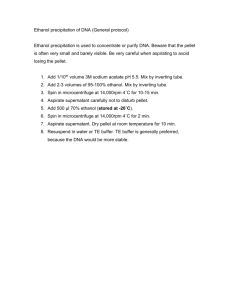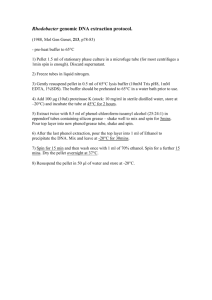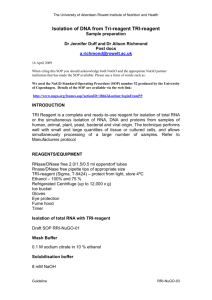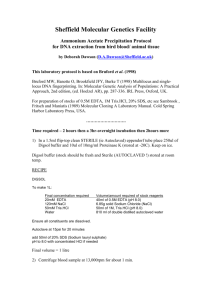Purification of Genomic DNA by Ethanol Precipitation
advertisement
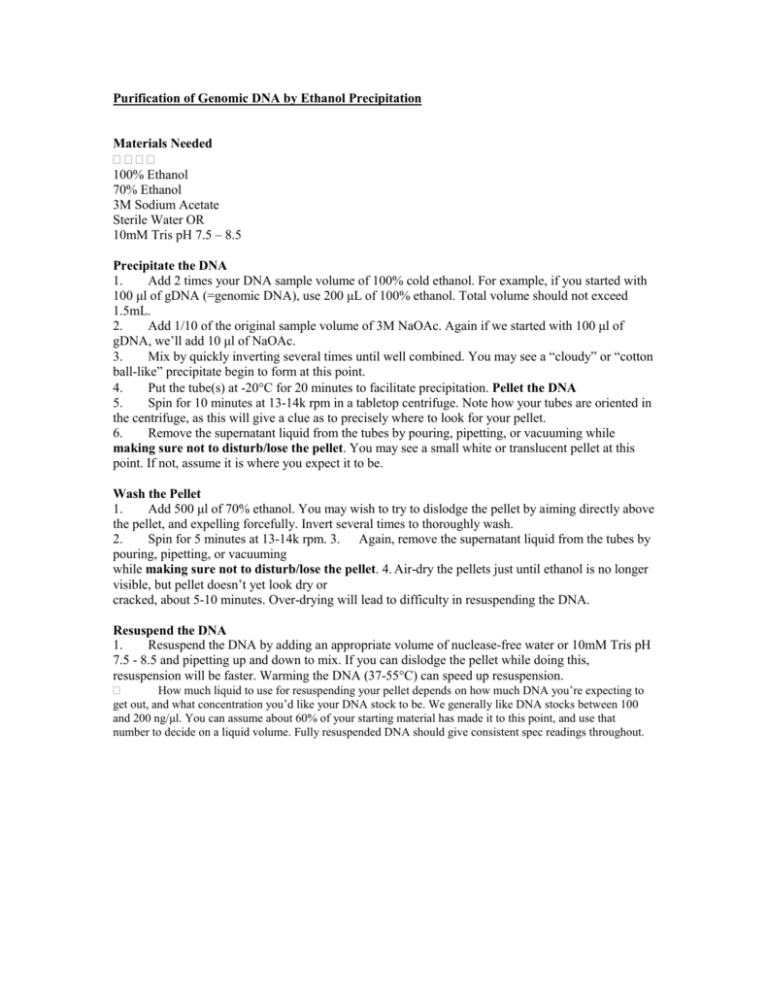
Purification of Genomic DNA by Ethanol Precipitation Materials Needed 100% Ethanol 70% Ethanol 3M Sodium Acetate Sterile Water OR 10mM Tris pH 7.5 – 8.5 Precipitate the DNA 1. Add 2 times your DNA sample volume of 100% cold ethanol. For example, if you started with 100 μl of gDNA (=genomic DNA), use 200 μL of 100% ethanol. Total volume should not exceed 1.5mL. 2. Add 1/10 of the original sample volume of 3M NaOAc. Again if we started with 100 μl of gDNA, we’ll add 10 μl of NaOAc. 3. Mix by quickly inverting several times until well combined. You may see a “cloudy” or “cotton ball-like” precipitate begin to form at this point. 4. Put the tube(s) at -20C for 20 minutes to facilitate precipitation. Pellet the DNA 5. Spin for 10 minutes at 13-14k rpm in a tabletop centrifuge. Note how your tubes are oriented in the centrifuge, as this will give a clue as to precisely where to look for your pellet. 6. Remove the supernatant liquid from the tubes by pouring, pipetting, or vacuuming while making sure not to disturb/lose the pellet. You may see a small white or translucent pellet at this point. If not, assume it is where you expect it to be. Wash the Pellet 1. Add 500 μl of 70% ethanol. You may wish to try to dislodge the pellet by aiming directly above the pellet, and expelling forcefully. Invert several times to thoroughly wash. 2. Spin for 5 minutes at 13-14k rpm. 3. Again, remove the supernatant liquid from the tubes by pouring, pipetting, or vacuuming while making sure not to disturb/lose the pellet. 4. Air-dry the pellets just until ethanol is no longer visible, but pellet doesn’t yet look dry or cracked, about 5-10 minutes. Over-drying will lead to difficulty in resuspending the DNA. Resuspend the DNA 1. Resuspend the DNA by adding an appropriate volume of nuclease-free water or 10mM Tris pH 7.5 - 8.5 and pipetting up and down to mix. If you can dislodge the pellet while doing this, resuspension will be faster. Warming the DNA (37-55°C) can speed up resuspension. How much liquid to use for resuspending your pellet depends on how much DNA you’re expecting to get out, and what concentration you’d like your DNA stock to be. We generally like DNA stocks between 100 and 200 ng/μl. You can assume about 60% of your starting material has made it to this point, and use that number to decide on a liquid volume. Fully resuspended DNA should give consistent spec readings throughout.
